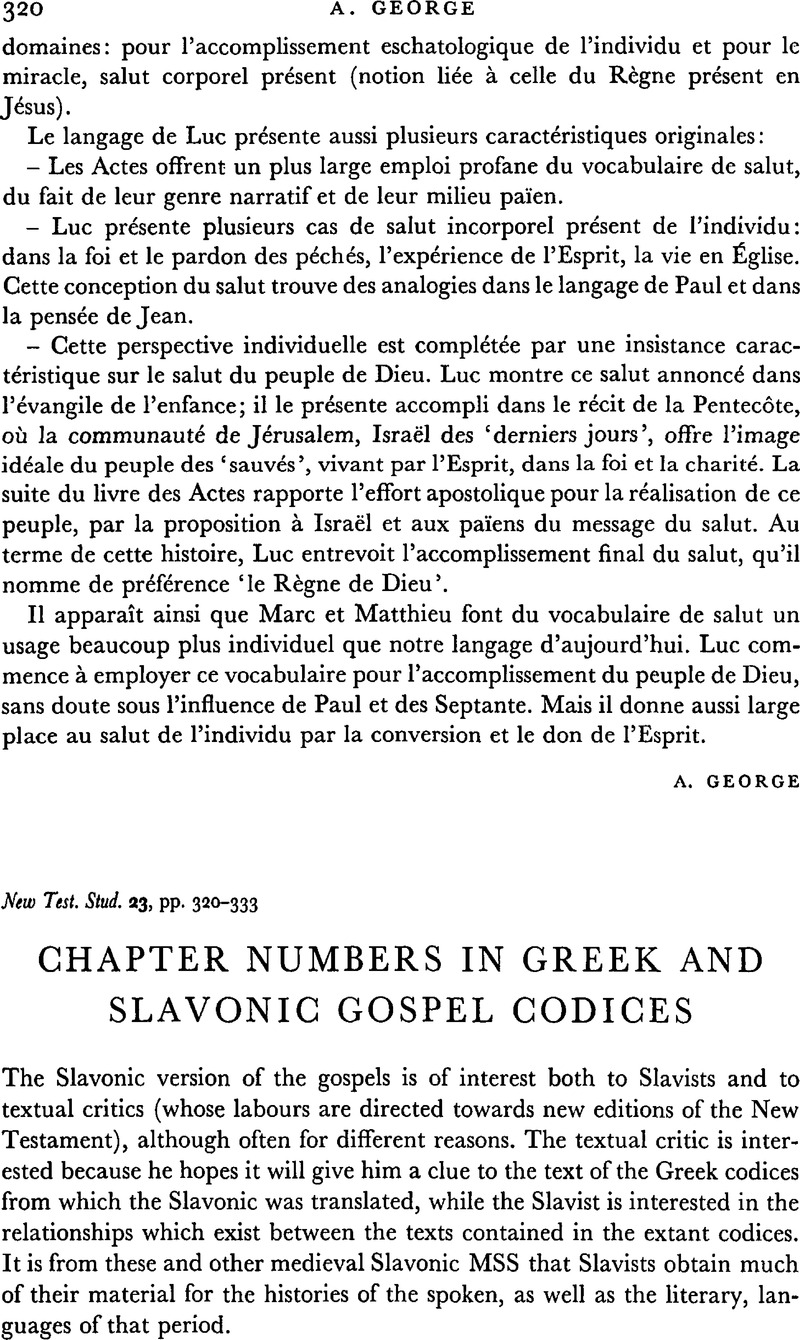No CrossRef data available.
Published online by Cambridge University Press: 05 February 2009

page 321 note 1 Horálek, Karel, Evangeliáre a čtveroevangelia (Prague, 1954)Google Scholar; Metzger, Bruce M., Chapters in the History of New Testament Textual Criticism (Leiden, 1963)Google Scholar, chapter III.
page 321 note 2 Slavonic inscriptions are found on some Greek gospel MSS, while one Greek inscription states that the lectionary concerned was written in Belgrade. Greek MSS are still preserved in Russian and Balkan libraries.
page 321 note 3 Burns, Yvonne, Kalinik's Lesnovo Gospel Lectionary (Skopje, 1976).Google Scholar
page 321 note 4 Gregory, C. R., Canon and Text of the New Testament (Edinburgh, 1907), p. 473.Google Scholar
page 321 note 5 Bibliothèque Bodmer, Papyrus Bodmer II (Cologny/Geneva, 1956, Supp. 1958); Sanders, H. A., The New Testament Manuscripts of the Freer Collection, I (New York, 1912).CrossRefGoogle Scholar
page 322 note 1 Soden, H. von, Die Schriften des Neuen Testaments (Göttingen, 1911), pp. 432–5.Google Scholar
page 322 note 2 Metzger, Bruce M., The Text of the New Testament (Oxford, 1964), pp. 58–9, 63–4.Google Scholar
page 322 note 3 Lake, Kirsopp, The Text of the New Testament (6th ed. 1953), p. 55.Google Scholar
page 322 note 4 Carrington, Philip, The Primitive Christian Calendar (C.U.P. 1952)Google Scholar; According to Mark (C.U.P. 1960), pp. 346–71.Google Scholar
page 322 note 5 For a review of Carrington's theory see Casey, R. P., ‘St Mark's Gospel’, Theology LV (1952), 362–70.CrossRefGoogle Scholar
page 322 note 6 Soden, H. von, op. cit. pp. 405–11.Google Scholar
page 322 note 7 According to Mark, p. 346.Google Scholar
page 323 note 1 Metzger, , op. cit. (Text), p. 22.Google Scholar
page 323 note 2 Scrivener, F. H. A., Introduction to the Criticism of the New Testament (4th ed.London, 1894), I, 57.Google Scholar
page 323 note 3 Carrington, , op. cit. (Mark), pp. 348–53.Google Scholar
page 323 note 4 Gregory, , op. cit. pp. 470–2.Google Scholar
page 323 note 5 Gregory, C. R., Textkritik des Neuen Testaments (Leipzig, 1900), I, 470–2.Google ScholarOliver, Harold H., Novum Testamentum III (1959), 138–45.Google Scholar
page 324 note 1 Burgon, J. W., The Last Twelve Verses of the Gospel According to St. Mark (1871), p. 311.Google Scholar
page 325 note 1 Gwilliam, G. H., The Ammonian sections, Eusebian canons and Harmonising Tables in the Syriac tetra-evangelium, Studia Biblica et Ecclesiastica II (Oxford, 1890), 241.Google Scholar
page 325 note 2 Jagić, V., Quattuor evangeliorum codex glagoliticus olim Zographensis nunc Petropolitanus (reprint Graz, 1954), pp. xiii–xiv.Google Scholar
page 327 note 1 Op. cit. 1, 75.Google Scholar
page 327 note 2 An asterisk has been used after the Gregory-Aland number when referring to lectionaries containing chapter numbers, e.g. l 292*. Since this is not used in the contexts where an asterisk is used with other meanings (such as the work of a corrector), it does not seem possible that any confusion can arise from the use of this convenient siglum.
page 328 note 1 Bray, William D., The Weekday Lessons from Luke in the Greek Gospel Lectionary, Studies in the Lectionary Text of the Greek New Testament, II, no. 5 (University of Chicago Press, Chicago, 1959), p. 32.Google Scholar
page 328 note 2 Ibid. p. 37.
page 328 note 3 Ibid.
page 328 note 4 Burns, Yvonne, ‘The weekday lection system of Miroslav's Gospel’, zbornik Narodnog muzeja u Beogradu (1970)Google Scholar; ‘A comparative study of the weekday lection systems found in some Greek and early Slavonic gospel lectionaries.’ Unpublished Ph.D. thesis.Google Scholar
page 329 note 1 Studies in the Lectionary Text of the Greek New Testament, I and II.Google Scholar
page 329 note 2 Burns, Yvonne, ‘The Karpina Gospel and a group of Greek weekday lectionaries’, Makedonski jazikGoogle Scholar (in preparation).
page 332 note 1 Yvonne Burns, ‘The Saturdays of Lent in the Slavonic gospel lectionaries’ (in preparation).
page 332 note 2 Two stars have been used to designate lectionaries containing this system of chapter numbers.
page 333 note 1 Vajs, J., Evangelium sv. Matouŝe, Evangelium sv. Marka, Evangelium sv. Lukàšfe, Evangelium sv. Jana (Prague, 1935–1936)Google Scholar, Kritické studie staroslovanského textu biblického, IIIGoogle Scholar, IV, V, VI.
page 333 note 2 Metzger, , op. cit. (Chapters), p. 94.Google Scholar
page 333 note 3 Scholars working on the Greek lectionary text have not differentiated between the S type and the k type, but the ten lectionaries which they have found to represent best the lectionary text consist of eight k-type and two S-type, while the one which represents it almost word for word, 1 69, is k-type. They have also discovered that the more Constantinopolitan features it contains, the closer is the text of a lectionary to the lectionary text. See Colwell, E. C., J.B.L. LXXXVII (1968)Google Scholar, on 189 ff. This confirms the present writer's contention, based on the contents and the external features of the lectionaries alone, that the k-type lectionary was an adaptation in Constantinople of an S-type lectionary (which had been evolved elsewhere), and that it had been multiplied by careful copying.